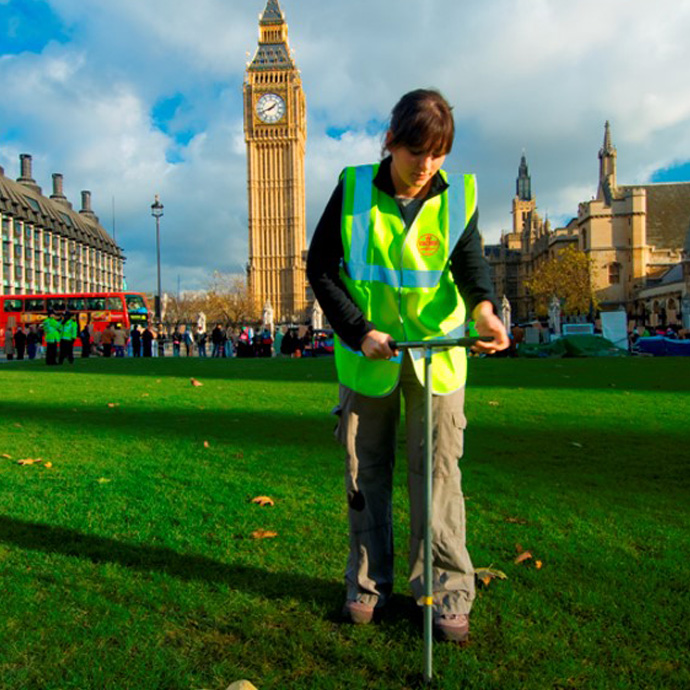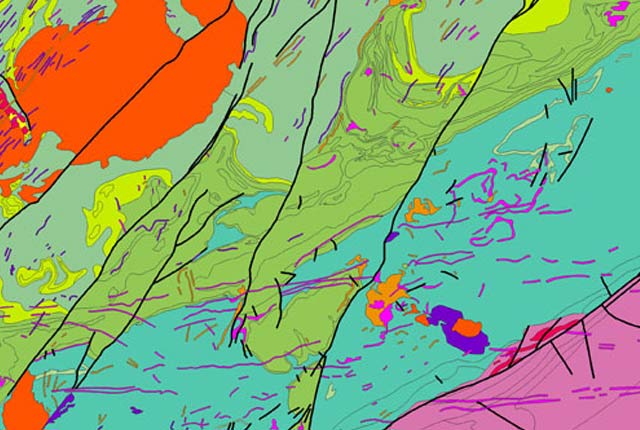What is the London Earth survey?
London Earth is part of our national programme, G-BASE, to measure and map the chemical status of the surface environment of Great Britain. Through this survey, the BGS quantifies geochemical variation in the shallow subsurface, including the soil beneath our cities.
Results
Results from the London Earth project provide valuable information on soil chemistry in the urban environment. Characterising the soil quality of London enhances our understanding of interactions between people and ecosystems.
The results are indicative and, where such information is being used for land-use planning and development, it is recommended a full site-specific investigation is carried out. The survey data provides baseline values to set the context for site-specific investigations.
Method
The London Earth survey collected soil samples at a density of four sites per square kilometre, comprising over 6000 sample sites across the entire Greater London Authority area.
At each site the concentrations of over 50 inorganic chemical elements and properties have been measured; a selection of the results are available online.
The survey used a systematic approach, which was not modified or targeted to particular land uses or anticipated contaminated sites. This ensured that the survey was not biased and measured what we term the baseline geochemistry.
Mapping in this way means that our results are robust and can be compared to other city-wide and national surveys.
Pollution and health Q&A
There is no simple answer for ‘how polluted is somewhere’, since both natural and artificial processes have resulted in chemical variations within the soil. The London Earth survey didn’t measure every type of environmental pollutant, only inorganic chemical elements.
The data we hold on urban soil chemistry shows that the concentrations of many chemical elements in London are similar to other UK cities. Each city shows characteristic variation based on its natural setting and industrial past and London sits within this range of variation.
The London Earth element maps for topsoils show areas with higher element concentrations relative to their surroundings, but such areas are not necessarily contaminated. We have not displayed the London Earth survey data relative to any guideline levels since there are only a few official Soil Guideline Values (SGV).
The London Earth data will provide a resource for research into the effects the soil chemical environment may have on people’s health, though this is the specialist area of health professionals and researchers and not directly within the remit of the BGS.
For answers to health-related questions, please contact your local authority or your local Health Protection Agency’s health protection unit.
They are not. The soil chemistry measured by the London Earth survey showed that the concentrations in London are similar to other urban surveys that we have carried out in cities across the UK.
There are many sources of chemicals in the environment; some are natural and some introduced due to human activities.
The London Earth survey detected the background, geological signature that we term the natural baseline geochemistry. Even this can display lots of variation in the concentrations of some chemical elements. A few examples of human activities that can change these background levels include:
- industry
- construction projects
- traffic
- agriculture
The data have been available since February 2011. We released this data into the public domain as quickly as possible and we are keen to work together with local authorities and researchers to better understand the results.
We make information on the environment available so that individuals and organisations can make informed decisions. There may be instances where local authorities may wish to do follow-up studies on the basis of the London Earth data.
Previous studies revealed that regional-scale data (similar to London Earth) showed that there was no need for concern. You can access more details on these follow-up studies in GSUE: urban geochemical mapping in Great Britain
No. The London Earth survey is a regional baseline survey intended to measure and map the background concentrations of a range of inorganic elements in soil. It is not intended to be used as a site-specific tool or to replace site investigations. However, it can be used to set the wider context around a more detailed site investigation for a specific site.
The London Earth survey is designed as a regional-scale, baseline survey and not for assessment of single sites. However, if you wish to look and assess the London Earth data in your area, you can download maps or use the interactive viewer.
The sample taken in your garden would give an indication of the level of many elements in the soil and, since the data is accurate, would allow you to compare this point to the rest of the range of data across London. However, due to the complex history of many urban soils (due to the intensity of their use) there are often big differences in the levels of elements over a short distance. Therefore one data point in a garden is not enough to give a true reflection of the range of levels of elements over the whole area of the garden.
A kilogram (kg) is one thousand grams. A milligram (mg) is one-thousandth part of a gram so a concentration of 1 mg/kg copper, for example, in a soil sample means that a kilogram of soil contains one milligram of copper. This could be compared to approximately 5 grains of sugar in a 1 kg bag.
It is possible to be exposed to small amounts of soil, for example, on food or in the air we breathe. It is also possible to directly eat soil accidentally. Young children are more likely to do this since they have more regular hand-to-mouth contact with soil during play.
For answers to health-related questions, please contact your local authority or your local Health Protection Agency’s health protection unit.
Yes. The concentrations of chemical elements measured by London Earth are consistent with other UK cities and don’t indicate any problems specific to London.
Arsenic
Arsenic (As) is an element that has a reputation as a poison, but it occurs widely at levels of a few tens of mg/kg in rocks and soils and, at these levels, has no harmful effects.
Some areas affected by industry and other human activities may have elevated arsenic levels and in such cases, further investigations of the potential for harmful effects may be carried out.
Cadmium
Cadmium (Cd) is a rare metal, usually present in soils at less than 1 mg/kg. It is used in industrial processes and in some rechargeable batteries. Since cadmium is potentially toxic, further investigations of the potential for harmful effects may be carried out.
Examples of poisoning even in cadmium-rich soils derived from lead and zinc mine waste and industrial wastes are very rare.
Calcium
Calcium (Ca) is a common element in nature, abundant in many rocks and soils and in artificial materials such as cement. It is non-toxic and essential to life, being a major component of bones and teeth.
Chromium
Chromium (Cr) is a relatively common, silvery metal, most commonly used in chromium plating and stainless steel. The metal and most of its compounds are generally not harmful, but some chemical forms of chromium in industrial wastes can present a risk to health.
Copper
Copper (Cu) is a metal that is widely used in coinage and electrical wire, for example. At low levels it is essential for life but may be harmful at very high levels.
Iron
Iron (Fe) is a common element, abundant in many rocks and soils and in many artificial materials such as steel. It is essential to life, being present in the red pigment (haemoglobin) in blood, for example.
Lead
Lead (Pb) is a metal and has no known biological function, but is potentially harmful if it enters the body. Even so, examples of lead poisoning from contaminated soils are very rare.
Other significant sources of lead exist in our environment and homes, for example leaded paint.
Nickel
Nickel (Ni) is a relatively common metal, present at a few tens of mg/kg in many soils. Some areas affected by industry and other human activities may have raised nickel levels, and in such cases, further investigations of the potential for harmful effects may be carried out.
Selenium
Selenium (Se) is a rare element that is essential for life in trace amounts but is potentially harmful at very high levels. The London Earth dataset has shown that very high levels of selenium are not likely to be present in London.
Zinc
Zinc (Zn) is a common metal being present at up to a few hundred mg/kg in many soils and perhaps an order of magnitude higher in those soils affected by industrial wastes. It is essential to life and generally has a low toxicity, but in areas with soils with a very high zinc levels, further investigations of the potential for harmful effects may be carried out.
Please contact our enquiry service:
enquiries@bgs.ac.uk
Tel: 0115 936 3143
You may also be interested in

London Earth
London Earth is the systematic, high-density, geochemical soil dataset of the Greater London Area (GLA) aiming to give insight into the environmental impacts of urbanisation and industrialisation on the UK’s most populous city.


